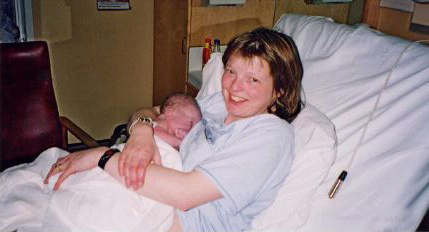This page as a pdf file
Using the insulin pump during pregnancy
Susan Morrow compares her first pregnancy, on multiple daily injections, with her second, on an insulin pump
Susan Morrow with her daughter Anna - 1 hour old. 23 April 2001

Introduction
I have had type 1 diabetes for 17 years and am mother to Andrew (born 30 December 1997) and Anna (born 23 April 2001). During my first pregnancy I managed my diabetes using an MDI regime of Humalog before meals and Insulatard before bed. I also tested my BGs before every meal, an hour after each meal, at bed time and on waking. During my second pregnancy I managed my diabetes using an insulin pump and tested my BGs on an average of 10 times each day. Both pregnancies, labours and post-natal experiences were quite different in many ways.
Pregnancy Number One
Following 18 months of fertility treatment I was delighted to finally become pregnant. However, the elation was quickly replaced by worry as it became clear to me how important tight control of diabetes is during pregnancy in order to ensure a successful outcome for mother and baby. Throughout my pregnancy I was cared for by a joint obstetric and diabetic team at the local maternity hospital. I attended the clinic every fortnight up until 34 weeks and thereafter weekly. I was also given regular ultrasound scans in order to ensure that all was well with the baby and that the baby was growing at a normal rate. From 34 weeks onwards I attended a day assessment unit twice a week in order to monitor the baby's heart beat, blood flow to the placenta and fluid volume around the baby. During the pregnancy I tried my utmost to achieve as normal blood sugars as possible. However, I was constantly troubled by waking hyperglycaemia or the dawn effect. Increasing the dose of Insulatard only resulted in hypos at around 3am which resulted in even higher waking levels. With the help of my diabetes care team I tried many different ways to combat the dawn effect e.g. splitting the insulatard between dinner and bed time, or bed time and 3am, but there didn't appear to be a magic formula for me. I spent most of my pregnancy waking at around 3-4am in order to test my BGs and take a chasing dose of humalog if necessary. Despite these problems I managed to achieve an acceptable HbA1c of 6.2% throughout most of my pregnancy although there were many swings in highs and lows masked within this reading.
Andrew & Anna Morrow. 28 April 2001

I was admitted once during my pregnancy, at 36 weeks as the baby was not very responsive during monitoring at the day assessment unit. After 48 hours of close monitoring I was given the all clear and discharged home.
As babies of diabetic mothers tend to be on the large size it was routine at my hospital for all babies to be born at 38 weeks. I was induced at 37 weeks and 4 days as the fluid volume around the baby had fallen significantly which can be a sign of foetal distress. The labour progressed well and after 6 hours Andrew was born. He was delivered by ventouse as near the end of my labour he started to show signs of distress. Unfortunately Andrew was a bit floppy and blue soon after delivery and was therefore transferred to the Special Care Baby Unit. This was very upsetting for myself and my husband as we were unsure exactly what had happened and if Andrew was going to be okay. We were very relieved to discover that all was well apart from hypoglycaemia as a result of being exposed to higher than normal blood sugars during the pregnancy. Andrew spent 5 days in the unit on a dextrose drip in order to control his blood sugars. This was a horrible experience as it was very difficult to bond with a baby in an incubator attached to monitors and drips and it was very hard to breast feed as I was terrified of knocking out the drips and disturbing all the monitors. I also experienced a lot of guilt as I felt responsible for inflicting a lot of pain and distress on Andrew during his first few days of life. However, once discharged from the unit Andrew continued to thrive and is a very healthy and happy little boy.
Pregnancy Number Two
When we decided to start fertility treatment for baby number two my diabetic consultant suggested trying an insulin pump in order to improve my control. I spent some time looking into pump therapy and was very encouraged by what I found. Therefore it was with great excitement that I started pump therapy on 26 July 2000. I was very lucky to fall pregnant only 4 weeks later by which time I felt that I had adjusted to the pump and was already starting to see a significant improvement in my glycaemic control.
My care during pregnancy number 2 was the same as the previous pregnancy although I was a bit of a novelty as I was and still am the only pregnant women in the hospital to use an insulin pump. This time I experienced no problems with waking hyperglycaemia and I found my diabetes so much easier to control. As previously, my insulin requirements more than doubled during the pregnancy. Using the pump it was easy to alter my basal rates and boluses to meet my changing requirements. I was never admitted to hospital during this pregnancy and experienced no complications. My HbA1c was similar to the previous pregnancy but there were fewer swings in blood sugar levels so my overall profile was much improved.
On this occasion I was allowed to go until 38 weeks and 5 days as the pregnancy had progressed so well. As it turned out I was already in the early stages of labour when I was admitted for induction. I kept my pump on during the short labour (3 hours) and by reducing my basal rate to 50% managed to achieve good control throughout. Anna was born naturally and, apart from a bit of distress after her shoulders got stuck during delivery, was declared healthy and was allowed to accompany me to the post-natal ward.
Anna Morrow. 25 April 2001

The experience with number two was so much better than with Andrew. I bonded with Anna straight away and managed to breast feed her without any problems. She required heel pricks for blood sugar readings for the first 48 hours as she was slightly hypoglycaemic. However, by day 3 she had established a regular feeding pattern and her blood sugars had reached an acceptable level. As soon as Anna was born I adjusted my basal rates to my pre-pregnancy levels. These had to be reduced again slightly due to the fact that I am breast feeding.
In comparison I feel that the pregnancy using the insulin pump was much easier than using MDI. I felt that I had control over my diabetes rather then the diabetes controlling me. Post-pregnancy the benefits continue. I can reduce the basal rates whilst feeding therefore avoiding hypoglycaemia and the need to constantly eat snacks. As a result I managed to get back into my pre-pregnancy clothes after only 2 weeks which for me is the best thing ever!
Created: May 2001; Last updated: Tuesday 5 June 2001
See also:
- Pumps in pregnancy - Kate Clapham tells us how a pump made her third pregnancy much easier than before.
Other pages about pumps
[ Funding issues | Pros and cons of pumping | Diabetes UK on pump therapy | Pumps in the Republic of Ireland | What is an insulin pump? | Just like wearing a yoyo | Not controlled, but in control! | Rewriting the diabetes rulebook | To pump or not to pump? | Pumps in pregnancy | Using the insulin pump during pregnancy | Life on a pump | UK pump news | Which pump? | MiniMed | Disetronic | Animas | Books to help with diabetes | Other pump websites | My pump ]
Reader comments
-
On 21 May 2006 Amanda Jewell wrote:
I'm 23 years old and I've had diabeties for 12 years now. I have one child who's 3 years old and I had a good pregnancy and wasn't using the pump, guess I was one of the lucky ones but my husband and I are trying for another one and after reading the stories I've decided to get the pump!! Thanks.
-
On 5 Apr 2006 Rachael wrote:
I had two pregnancies using multiple injections, and a third pregnancy with a pump. For the first two, I had to battle to keep blood sugars under control - and the doctors didn't (I felt) have any conception of how difficult it was. I had frequent hypos. During breast feeding I had the worst hypos I've ever experienced, and once required a doctor to give me a glucose injection. The third pregancy with a pump was SO much better - and I had the best blood glucose figures they had ever had in the clinic. I felt in control. The doctors still asked for ridiculous control (I remember them saying that 5.9 was still a bit high for a waking blood sugar, and they would prefer 5.2!)- but as I felt so much more in control, I could laugh at them. In either of my previous pregnancies I would have had waking sugars ranging from 2.0 to 19.0. I didn't have any problems with dangerous lows whilst breast feeding either. There was no doubt which was easier.
-
On 13 Oct 2004 Kelly Lloyd wrote:
I am so relieved to hear this story!! I have one son who is now 6 years old, but when I was pregnant with him I did not have diabetes. I have only had it 4 years. Now my husband and I would like to have another baby and I have been so scared, and this story has helped me make up my mind!!! Thank you so much!!
-
On 18 Sep 2004 Tola wrote:
Hi!! Reading your story, touched a special part of my heart... although I am 19, (and very far from ever getting pregnant), your story gives me hope, as I have been a diabetic for 9 years, and have a hard time keeping my bloodsugars under control..hopefully in the future, I can have healthy children as you do! Thanks again for sharing your honest and beautiful story..!
Wishing you luck with everything,
Tola
-
On 21 Aug 2004 Sammy xxx wrote:
It's been so good to read up on other women using insulin pumps!!!!
I've been diabetic for 14 years, and found out I was expecting my first baby 4 weeks ago! I was so scared as I read horror stories of diabetic women having such a hard time! BUT I do have an insulin pump!! and reading here that it makes life easier has put my mind to rest!
-
On 17 Mar 2002 Ammah Adu wrote:
I have just read the stories regarding wearing a pump during pregnancy and feel relieved! I have just found out I am 10 weeks pregnant and have had a pump for about 8 months. Although I have had diabetes for 24 years I have never had tight control but the pump has put an end to this. It's nice to be able to read other peoples experiences as sometimes you do feel a bit of a loner.
